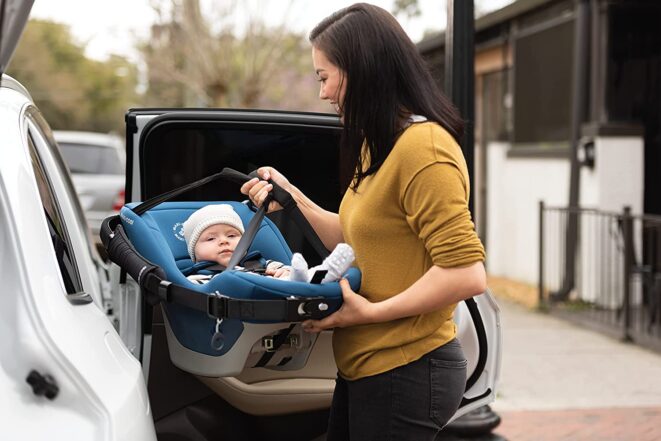We know how important car seats are to keep your baby safe while traveling, but with so many options out there, choosing the right car seat for your baby can be a bit challenging. Here we break down the options depending on your baby’s weight, height, and age, so you can pick the safest and most comfortable seat.
Infant Car Seats
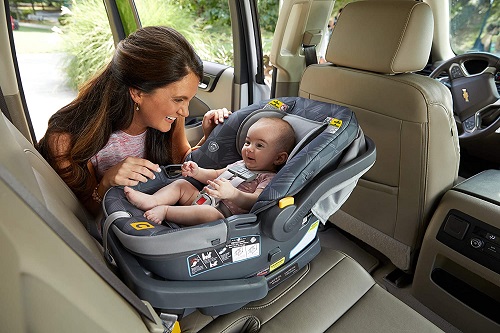
Infant car seats are specially made for infants and babies. Some can be used as a carrier, meaning you can take your baby out of the car in their car seat. Some infant car seats are also stroller-compatible, meaning you can attach them onto a stroller base to form a traveling system. Depending on the brand of your car seat and your stroller, you may need an adapter.
The usual height and weight limits for infant car seats are from birth to 2o lbs to 35 lbs with a maximum height of 28 to 35 inches.
Rear-facing
Infant rear-facing car seats usually have a base designed to keep the seat properly buckled in the back seat, while it can also be used as a carrier and are specially made to protect newborns up to 2-year-old babies. This type of car seat should only be at a rear-facing position at all times.
B-Safe Gen2 FlexFit Plus has a spacious seating area and tagless smooth-touch knit fabric which makes it a good choice for many parents. It can carry your baby from 4 – 35 lbs & up to 32″ in height. It provides head-to-toe safety protective foam, and a quick-adjust 5-point harness & headrest.
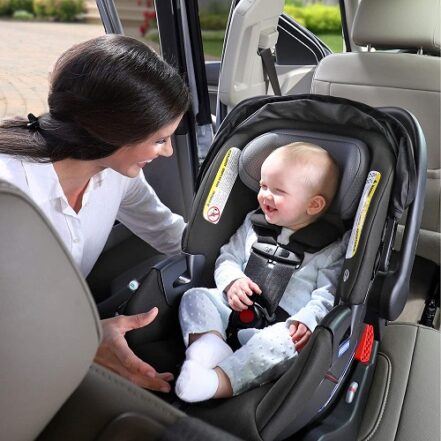
Convertible seat
Convertible seats are made to stay in the car, so you can’t use them as a carrier. But because this type of seat can be adapted to grow with your child, it will fit your baby from birth up to 50 lbs. Using this seat with a harness that connects over the shoulders, around the hips and between the legs (a 5-point harness) is an added safety assurance.
Graco Extend2Fit is one such convertible car seat, that is perfect for parents who want a long-lasting car seat. It can carry your child in a rear-facing position from 4-50lbs, and later in a forward-facing position from 22-65 pounds.

All in one car seat
An all-in-one car seat can be used in any position: either rear-facing, forward-facing, or as a belt-positioning booster. This means you can basically use the same seat from your baby’s first ride from the hospital through to their school years needing a booster seat.
This car seat is often made in a larger size, so you may consider checking it first if the car seat will fit in the vehicle while the seat is in a rear-facing position. It doesn’t have a carrying handle or separate base that you can leave installed in your car. All in one seat is ideal for bigger babies and toddlers.
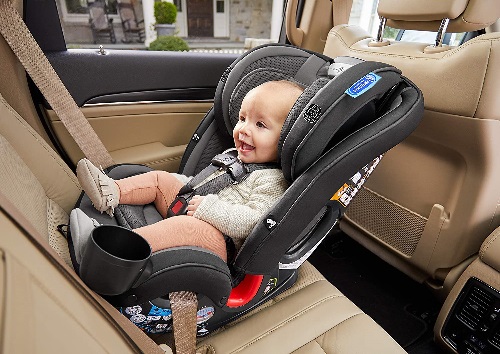
Graco SlimFit3 LX3-in-1 car seat grows with your child. You can start with it in a rear-facing position while your baby is between 5 and 40lbs. From 22 to 65lbs, the seat can be in a forward-facing position. You can then remove the side pieces to form a highback booster, which will hold your child safely from 40 to 100lbs. The seat has a narrow design, which is a great compromise between giving your child enough space and enabling you to fit three car seats in your back seat if needs be!
What about Preemies?
While the choice of car seat can be a struggle for many parents, it’s even more concerning for preemies who need extra care. A car safety seat must be approved based on your baby’s weight, and you might need a preemie insert to ensure they fit snugly and safely in the car seat. Preemies should also be screened before leaving hospital to ensure your child is ready to use a car seat.
Your little babies must sit safely in a semi-reclined position and rear-facing–only seats. Infant car seats are usually designed to carry your baby in a “bucket” position, which keeps them at a safely reclined angle and makes sure their airways stay open.
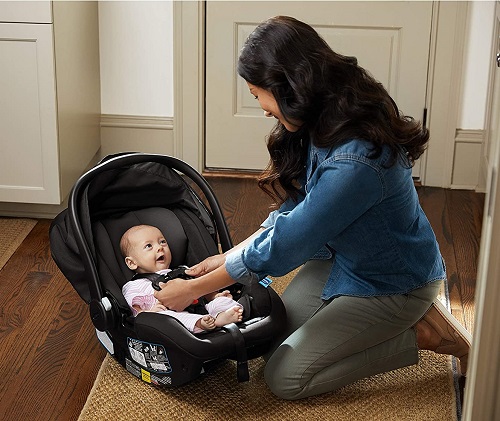
While healthy full-term babies over 4lbs may be able to ride in a different type of car seat, such as a convertible or all-in-one, rear-facing infant car seats are the safest option for premature babies.
These car seats usually have a base and easily click into and out of the base and have a carrying handle. It is convenient to use a rear-facing only car seat since you don’t have to install the seat each time you use it as an infant carrier. This type of car seat usually can carry an infant up to 22 to 35 pounds.
Graco SnugFit 35 Infant Car Seat has a lot of good feedbacks from parents. One of the best features of this infant car seat is the Anti-Rebound Bar that provides an additional layer of safety, especially for preemies. Headrest and harness adjust together while your child is in the seat. It has a 4-position adjustable base that offers 4 recline positions.
Toddler car seat
When your toddler reaches their second birthday or grows beyond the maximum height and weight limit for a rear-facing seat, you can safely switch your baby to a front-facing seat.
Convertible seat
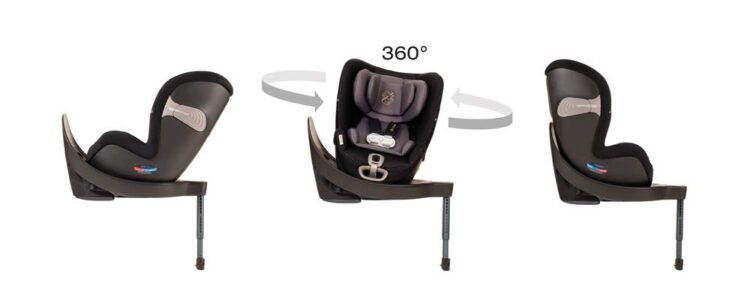
Convertible seats make the switch from rear facing car seat to forward facing car seat super easy, to suit your child as they grow.
The Sirona S is the first rotatable seat in the U.S. The car seat itself rotates on the base, making it easy to move between rear-facing and forward-facing positions, as well as making it extra convenient to get your child in and out of the seat. It uses an EasyLock Bar for easy and secure installation. The best feature of Sirona S is the SensorSafe app that alerts you if your child unbuckles themselves, if the back seat has become too warm or too cold, or if you accidentally leave your child behind.
Booster Seat
Booster seats are needed for older kids who have outgrown their car seats, but are still too small to use a regular seat belt. The idea of the booster is that it lifts your child up, so that the seat belt sits across the strong bones of the chest and pelvis.
There are two standard types of booster seats and they are designed to lift a child on the seat just like how an adult sits on the car. High-back booster seats are made to fit 8 to 12 years old kids. High-back boosters are used in vehicles with lower-back seats or without headrests.
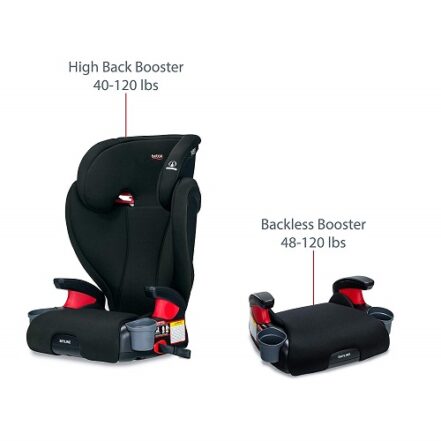
These seats sometimes have harnesses as well. Backless booster seats are lightweight and don’t have a back at all and usually have armrests and cup holders. Britax Skyline 2 is a 2-in-1 high back booster car seat that can be converted into a backless booster. It will last your child up to a weight of 120 lbs or height of 63 inches.
Rear-facing vs. Forward-facing car seat
Rear-facing is the safest way for children to ride. Rear-facing seats have been shown to support your child’s head, neck, and spine from the impact of a collision, making them the safer choice. However, as your child grows they will eventually need to move to a forward-facing position, particularly as they get longer legs! Forward Facing seat installation is not too different from installing a rear-facing one. The harnesses on a front-facing car seat hold your child in place by focusing on keeping their shoulders and hips.
Seat belt or LATCH?
Infant car seats can connect to your car using the seat belt or LATCH (or ISOFIX) system. LATCH stands for Lower Anchors and Tethers for Children, and involves hooks and tethers that connect from your car seat to the back seat of your car. This provides extra stability, although it’s not as easy to move the car seat in and out.
Alternatively, your car seat may connect securely to your car using the existing seat belt, which threads through connectors on the car seat to hold it in place. This can be fiddly when you first set it up, but is something you can get used to!
Factors to look for in finding the correct car seat
Here are few factors that you might consider when deciding on the best car seat for your babies and kids.
Safety
In the United States, vehicle crashes are one of the leading causes of death among children. To keep your baby safe while you are traveling with your vehicle you must know what helps to keep your baby away from danger. A car seat is designed to protect your child’s body. Your baby’s neck and spinal cord aren’t strong enough to hold the weight of their heads as they get propelled forward in an accidental crash force. So it is very important to choose the appropriate child seat.
One of the most important features of car seats is they absorb the crash energy and spread it equally along their body. Buckle your children with appropriate car seats, booster seats, and seat belts to avoid the risk of serious and fatal injuries.
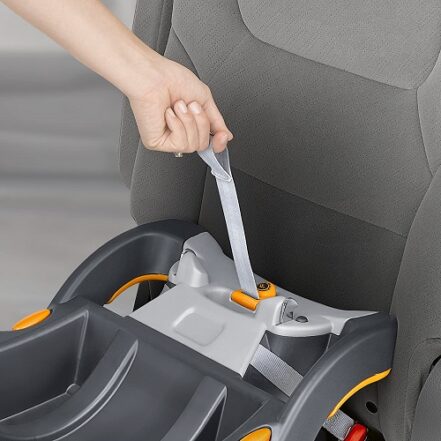
Budget
Finding quality car seats at a good and reasonable price is a real treasure. So we’ve done thorough research about how much do you need to buy a car seat based on its type.
- Infant car seats are generally available from about $70 up to $200. Chicco Keyfit Infant car seat and Britax B-safe Gen-2 Infant car seat are some of the best car seats with good quality at an affordable price.
- Booster seats are the most affordable car seat for older kids. You can buy a backless type of booster seat starting from $30 up to $150. Graco Atlas 65 is a 2 in 1 type of high back booster: it can be used as a forward-facing harness seat, or converted into a high back belt-positioning booster seat.
- Convertible seats are a great choice if you want an infant seat to last a bit longer. Britax Marathon is a great option in the $200-$300 range, which gives you rear-facing and forward-facing car seat options.
- All-in-one car seats are often the most expensive, but they also last the longest. The Graco 4Ever DLX boasts 10 years of use and four different uses, as a rear-facing infant seat, front-facing toddler seat, high-back booster for young kids and a backless booster for older kids.
Longevity/ Durability
Most car seats come usually with an expiration date between five and 10 years after they were manufactured. A car seat’s lifespan will be reduced if it was involved in a crash or sustains damage to the structure.
Maintenance
A car seat is designed to keep your child safe. A car seat manufacturer provides special instructions on how to maintain the cleanliness of the car seat during the lifespan of the seat and also how to install it safely to be more effective in providing safety.
Make sure you pick a car seat that is easy to clean, because dust, dirt, and spilled milk or food can cause build up of unwanted germs. Most car seats come with machine washable covers, but straps will need to be cleaned manually.
Final Thoughts
The American Academy of Pediatrics advise that rear-facing seats with a five point harness offer the best child passenger safety, and should be used for as long as they fit properly. Make sure your child is within the weight or height limits of your car seat, according to the manufacturer’s instructions.
When choosing the right car seat for your infants and toddlers, think about what you plan to do when your child outgrows this stage. Do you want an infant car seat that is part of a convenient travel system in the early days, and then replace it when your child outgrows it? Or would you prefer a car seat your child can use until they’re ready to use a shoulder belt?
One thing’s for sure: Child safety comes before design and budget when choosing which car seat is appropriate for your kids.

